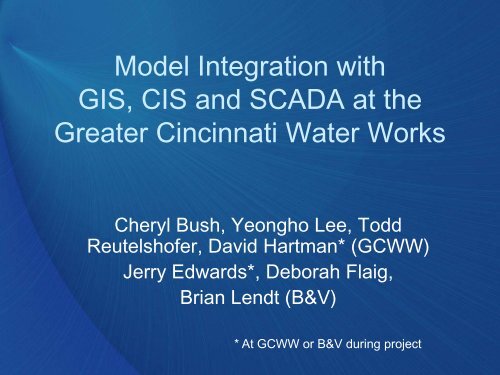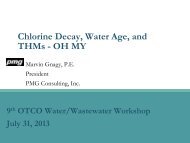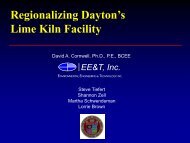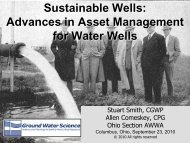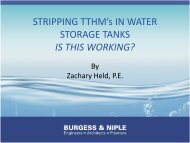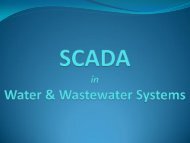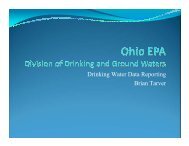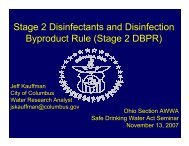GCWW Model Integration Methods with GIS, CIS ... - Ohiowater.org
GCWW Model Integration Methods with GIS, CIS ... - Ohiowater.org
GCWW Model Integration Methods with GIS, CIS ... - Ohiowater.org
- No tags were found...
Create successful ePaper yourself
Turn your PDF publications into a flip-book with our unique Google optimized e-Paper software.
<strong>Model</strong> <strong>Integration</strong> <strong>with</strong><br />
<strong>GIS</strong>, <strong>CIS</strong> and SCADA at the<br />
Greater Cincinnati Water Works<br />
Cheryl Bush, Yeongho Lee, Todd<br />
Reutelshofer, David Hartman* (<strong>GCWW</strong>)<br />
Jerry Edwards*, Deborah Flaig,<br />
Brian Lendt (B&V)<br />
* At <strong>GCWW</strong> or B&V during project
Overview / Agenda<br />
Physical Facilities<br />
– <strong>GIS</strong>: Integrate for maintenance<br />
– Facility Schematics<br />
– Pump Curves<br />
– Tank Geometry<br />
Demand Data (Allocated AAD)<br />
– <strong>CIS</strong> (Billing data): Integrate for maintenance<br />
– Non-revenue water<br />
Operational Data<br />
– SCADA: Integrate for operational evaluations<br />
– Valve status (open/closed) and settings
Greater Cincinnati Water Works<br />
(<strong>GCWW</strong>) System Profile<br />
<strong>GCWW</strong> provides about 136 million gallons a day<br />
through 3,000 miles of water main<br />
235,000 residential and commercial accounts<br />
Serves over 1,000,000 people<br />
<strong>GIS</strong> contains 200,000 pipes as of Jan. 1, 2008<br />
One of the largest All-Pipes hydraulic model ever<br />
constructed<br />
Selected H2OMAP Software by MWHSoft to<br />
perform hydraulic modeling
Geographical Information System<br />
(<strong>GIS</strong>)<br />
Source of Distribution System Records<br />
ESRI Arc Map Geometric Network<br />
Mains, Valves, Fittings, Hydrants<br />
Pump Station and Storage Tank<br />
schematics only. Size and Capacity<br />
information in other records.<br />
Additions & Corrections during model<br />
construction need to be added to <strong>GIS</strong>
<strong>GIS</strong> Data<br />
Data contained in <strong>GIS</strong> Database<br />
– Installation Date<br />
– Rehabilitation Date (Clean & Line)<br />
– Abandonment Date<br />
– Size<br />
– Material Type
<strong>GIS</strong> Issues<br />
Discretation<br />
– Current <strong>GIS</strong> allows for complex edges<br />
– <strong>GCWW</strong> <strong>GIS</strong> created <strong>with</strong> much detail<br />
– Branches complex<br />
– Valves and Fire Hydrants break pipe lengths<br />
Connectivity<br />
– Critical
Establishing <strong>GIS</strong> Network<br />
Connectivity<br />
Evaluate network connectivity in <strong>GIS</strong><br />
prior to model development<br />
Topology rules:<br />
– Fittings at endpoint of main<br />
– Hydrants at endpoint of main<br />
– Mains must not overlap<br />
– Mains must not self-overlap<br />
– Pumps at endpoint of main<br />
– Valves must be at endpoint of main<br />
– Water Storage units (reservoir/tank)<br />
must be at endpoint of main<br />
Over 300 topology errors existed<br />
Built “Geometric Network” in <strong>GIS</strong> to<br />
maintain connectivity
Network Connectivity/Topology<br />
<br />
<br />
<br />
<br />
<br />
<br />
<br />
<br />
No duplicate database records (duplicate<br />
features <strong>with</strong> identical IDs & attributes)<br />
No orphan nodes<br />
No duplicate nodes<br />
Pipes must not overlap other pipes<br />
Pipes must not self-overlap<br />
Pipes must not self-intersect<br />
Pipes must be split at intersections or<br />
(exceptions allowed)<br />
Pipe endpoints must be covered by nodes
“Points and Lines” <strong>GIS</strong> vs.<br />
Hydraulic <strong>Model</strong><br />
<strong>GIS</strong> Database<br />
Hydraulic <strong>Model</strong> (H2OMAP)<br />
Features Feature Type Features Feature Type<br />
Tanks/Reservoirs Point Tanks/Reservoirs Point<br />
Fittings, hydrants,<br />
non-operational<br />
valves<br />
Point Junctions Point<br />
Operational Valves Point Valves Line<br />
Pumps Point Pumps Line<br />
Pipes Line Pipe Line
Relating <strong>GIS</strong> <strong>with</strong><br />
Hydraulic <strong>Model</strong> in H2OMAP<br />
Asset ID’s are the key for 1:1 relationship <strong>with</strong> <strong>GIS</strong><br />
Representing Pumps and Valves in H2OMAP<br />
Valve representation in <strong>GIS</strong><br />
Valve representation in Hydraulic <strong>Model</strong><br />
<strong>GIS</strong><br />
<strong>GIS</strong><br />
12”<br />
P-6 P-7<br />
8” 8”<br />
Ð % î" Ð% î"<br />
16”<br />
V-1<br />
10” 10”<br />
P-1 P-2 P-3 P-4<br />
16”<br />
P-5<br />
All-Pipes <strong>Model</strong><br />
8” 8”<br />
P-6 P-7<br />
V-1<br />
V-1_ND<br />
12” 16” 10” 10”<br />
P-1 P-2 P-3 P-4<br />
V-1_NU<br />
16”<br />
P-5
Constructing the <strong>Model</strong> in H2OMAP<br />
Exported pipes from <strong>GIS</strong> to H2OMAP software<br />
Exported facility data (pump stations, control<br />
valves, tank facilities) to H2OMAP<br />
Hydraulic <strong>Model</strong> QC<br />
– Orphaned nodes & pipes<br />
– Nodes in close proximity<br />
– Parallel pipes<br />
– Diameter discrepancy<br />
– Network trace
Facility <strong>Model</strong> Development<br />
<br />
<br />
<br />
<br />
Developed from <strong>GIS</strong> data<br />
Schematic drawings used to verify facility<br />
network<br />
SCADA data used to refine operational<br />
information<br />
Provided documentation of additions,<br />
subtractions, and/or modification of<br />
facility elements to client<br />
<strong>GIS</strong><br />
Hydraulic <strong>Model</strong><br />
Facility Schematic
<strong>GIS</strong> & <strong>Model</strong> Issues<br />
To include hydrants or not<br />
– No. of hydrant segments = 62,000 pipes *<br />
– No. of pipe segments = 200,000 *<br />
<strong>Model</strong> Performance vs. One-to-One<br />
– <strong>Model</strong> Execution Time vs Maintenance<br />
– Trim “spurs”<br />
– Combine small pipe segments <strong>with</strong> others<br />
– Auto skeletonization<br />
( * <strong>GIS</strong> status as of Jan 2008)
<strong>GIS</strong> & <strong>Model</strong> Issues<br />
<strong>GIS</strong> IDs generally not descriptive<br />
MODEL IDs need to be descriptive enough to<br />
help calibration of model<br />
WARNING: Pump EQ0000015<br />
open but exceeds maximum<br />
flow at 7:00:00 hrs.<br />
Page 44<br />
WARNING: Negative pressures at demand node(s) at 7:00:00 hrs.<br />
WARNING: FCV 6519.1 open but cannot deliver flow at 7:00:00 hrs.<br />
WARNING: FCV EQ009221A open but cannot deliver flow at 7:00:00 hrs.<br />
WARNING: FCV EQ009417 open but cannot deliver flow at 7:00:00 hrs.<br />
WARNING: FCV EQ009867B open but cannot deliver flow at 7:00:00 hrs.<br />
WARNING: FCV EQ009958A open but cannot deliver flow at 7:00:00 hrs.<br />
WARNING: FCV EQ009965 open but cannot deliver flow at 7:00:00 hrs.<br />
WARNING: FCV EQ009974E open but cannot deliver flow at 7:00:00 hrs.<br />
WARNING: FCV EQ019948A open but cannot deliver flow at 7:00:00 hrs.<br />
WARNING: FCV UNKVF1 open but cannot deliver flow at 7:00:00 hrs.<br />
WARNING: FCV UNKVF2 open but cannot deliver flow at 7:00:00 hrs.<br />
WARNING: FCV UNKVF3 open but cannot deliver flow at 7:00:00 hrs.<br />
WARNING: Pump EQ000015 open but exceeds maximum flow at 7:00:00 hrs.<br />
WARNING: Pump EQ000022 open but exceeds maximum flow at 7:00:00 hrs.<br />
WARNING: Pump EQ001017 open but exceeds maximum flow at 7:00:00 hrs.<br />
WARNING: Pump EQ009436 open but exceeds maximum flow at 7:00:00 hrs.<br />
WARNING: Pump EQ009439 open but exceeds maximum flow at 7:00:00 hrs.<br />
WARNING: Pump EQ009440 open but exceeds maximum flow at 7:00:00 hrs.<br />
WARNING: Pump EQ009443 closed due to its inability to deliver head at 7:00:00 hrs.<br />
WARNING: Pump EQ009444 closed due to its inability to deliver head at 7:00:00 hrs.<br />
WARNING: Pump UNKPU8 open but exceeds maximum flow at 7:00:00 hrs.<br />
WARNING: Pump UNKPU9 open but exceeds maximum flow at 7:00:00 hrs.<br />
WARNING: System unbalanced at 7:00:00 hrs. EXECUTION HALTED.<br />
** Error: hydraulic simulation failed **
Customer Information System<br />
(<strong>CIS</strong>)<br />
Billing System Characteristics<br />
– Premise Code for one property<br />
– Each meter has one service<br />
– Multiple Services may be linked to one Premise<br />
– Numerous usage type codes (single-family<br />
residential, commercial, school, etc.)<br />
Allocation of Sales from <strong>CIS</strong><br />
– Multiple <strong>CIS</strong> usage types combined into two<br />
consolidated usage types (residential, ICI)<br />
– Consumption summed for each Premise by usage<br />
type
Demand Allocation<br />
Allocation of year 2007 annual average day use<br />
– Domestic use from <strong>CIS</strong>:<br />
• residential and ICI metered usage<br />
– Wholesale customers:<br />
• metered but special handling required<br />
– Unmetered water:<br />
• apparent losses, real losses, unmetered uses<br />
Various demand conditions created using<br />
demand manager and peaking factors
Linking Metered Sales to <strong>Model</strong><br />
<strong>CIS</strong> contains premise number for all<br />
accounts<br />
Premises are mapped in <strong>GIS</strong><br />
Tap location in <strong>GIS</strong> allows for accurate<br />
allocation<br />
Use spatial link in <strong>GIS</strong>
Legend<br />
") banner_consumption_by_quarter_2005<br />
") BranchTap<br />
") MeterInfo<br />
branch<br />
cww_branch_premises_fishbones<br />
<strong>Model</strong>_pipe
Demand Issues<br />
Unmapped Premises and Branches<br />
caused minor losses in demand allocation<br />
Domestic Water Demands only<br />
Monthly vs Quarterly Readings<br />
– Annualized data only<br />
Must include Water Loss in demand<br />
calculation to match actual AAD water use<br />
in system (consumption)
SCADA<br />
Source of operation data <strong>with</strong> 10 year storage<br />
Flow, Pressure, Pump Status, Valve Opening,<br />
Storage Water Level, Water Quality Monitor<br />
Values<br />
Desire ability to import operational conditions<br />
to calibrate or to balance model to specific<br />
conditions
SCADA System<br />
Each signal has specific SCADA Tag ID<br />
– SCADA Identifier is descriptive on Tag function<br />
– SCADA Identifier is longer than model ID allows<br />
– <strong>GIS</strong> Identifier vs SCADA Identifier<br />
Multiple signals for single equipment<br />
– Pump: on time, off time, speed<br />
– Valve: open status, close status,<br />
transition or percentage<br />
– Flow meter
SCADA Link<br />
Add field in <strong>Model</strong> for SCADA Tag ID<br />
Maintain Cross Index Table of IDs Among <strong>GIS</strong>,<br />
<strong>Model</strong> and SCADA (spreadsheet application)<br />
Operation data from SCADA imported into<br />
spreadsheet application <strong>with</strong> <strong>Model</strong> IDs for<br />
import to model<br />
– Alternative suggestion: Consider using this<br />
spreadsheet to help provide more descriptive ID<br />
names at key facilities for error messages.
<strong>Model</strong> Maintenance<br />
How are changes made in <strong>GIS</strong><br />
– Abandon original pipe, valve, hydrant, etc<br />
– Install new pipe, valve, hydrant<br />
Demands<br />
– Infrastructure replaced<br />
– New infrastructure<br />
Upgrade to <strong>GIS</strong>, <strong>CIS</strong>, or SCADA Systems can<br />
affect integration<br />
Platform of <strong>Model</strong>ing Software<br />
– <strong>GIS</strong>, CAD or stand alone<br />
– Manual vs Automatic process
Maintenance Issues<br />
How often<br />
Recalibrate<br />
Effort required vs. improved accuracies
<strong>Model</strong> Update Steps<br />
Update piping network: <strong>GIS</strong> and Hydraulic <strong>Model</strong><br />
tools<br />
– Flag in <strong>GIS</strong> all pipes not used in previous model<br />
construction(s)<br />
– Flag in <strong>GIS</strong> all abandoned mains<br />
– Assignment and/or modification of C-values<br />
Update facilities<br />
– New or modified facilities<br />
– Update pump performance tests<br />
– Changes to control valve settings<br />
Update AAD allocation
Summary<br />
<strong>Integration</strong> allows for more accurate model<br />
– Pipe Network, Demands<br />
<strong>Integration</strong> allows for future flexibility<br />
– Operational Conditions<br />
– Maintenance<br />
<strong>Integration</strong> requires balancing of needs
Contact Information<br />
Greater Cincinnati Water Works<br />
Cheri Bush, P.E. cheri.bush@gcww.cincinnati-oh.gov<br />
Yeongho Lee, P.E. PhD. yeongho.lee@gcww.cincinnati-oh.gov<br />
Todd Reutelshofer todd.reutelshofer@gcww.cincinnati-oh.gov<br />
David Hartman (formerly at <strong>GCWW</strong>)<br />
Black and Veatch<br />
Jerry Edwards, P.E. (formerly at B&V)<br />
Brian Lendt<br />
Deborah Flaig


